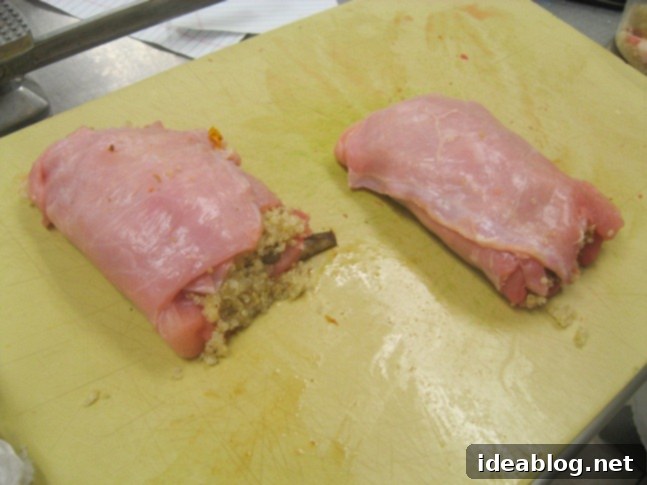Culinary Journeys: Mastering Week 20’s Exquisite Menu and Practical Exam Preparation
The weekend, as it often does, seemed to vanish in a flash, leaving me with little time to jot down a quick update. Before I knew it, I was back in the bustling kitchen classroom, fully immersed in the demands of Week 20. This particular week promises to be an intense one, culminating in our fifth and notoriously challenging practical exam this Friday, alongside yet another crucial theory exam. The pressure is certainly building, but so is the excitement of putting all our learned techniques to the test in a real-world scenario.
Overall, the menu we tackled this week was quite spectacular and incredibly rewarding to prepare. I daresay it was a significant step up from last week’s sweetbreads, both in complexity and sheer deliciousness. Each dish presented its own set of unique challenges and learning opportunities, pushing us to refine our skills and truly understand the art of fine dining preparation.
The First Course: Pan-Seared Potato-Encrusted Rockfish with Vibrant Green Olive Sauce
Our journey began with a beautiful and elegantly presented potato-encrusted rockfish, accompanied by a vibrant green olive sauce. The initial step, as with many fish dishes, was to meticulously break down the rockfish. While I’m continually improving, filleting round fish still requires considerable practice and precision. The goal is always to yield perfect, boneless fillets with minimal waste, a skill that is fundamental in any professional kitchen. Learning to handle the knife with such delicacy and confidence is a continuous process, and each fish broken down adds to my proficiency.
Following the filleting, we embarked on the intricate process of preparing the potato crust. This involved slicing potatoes to an almost translucent thinness using a deli slicer – a tool that allows for incredible uniformity and precision. These delicate potato slices were then gently brushed with melted clarified butter, which not only adds richness but also promotes even browning and crispiness. With utmost care, we meticulously wrapped these buttery potato slices around each rockfish fillet, ensuring a complete and even covering. To add a subtle hint of freshness and a pop of color, finely chopped chives were incorporated into the potato layering. Just before service, these potato-wrapped fillets were seared on both sides in a hot sauté pan. The high heat allowed the potatoes to achieve a wonderfully golden-brown, crispy exterior, while simultaneously cooking the fish through to a perfectly moist and tender interior. The contrast in textures was delightful, and the potatoes effectively locked in the fish’s moisture and delicate flavor.
Complementing the rockfish was a distinctive green olive sauce, which added a bright and briny element to the dish. The preparation began by blanching the green olives to temper some of their inherent saltiness, ensuring the sauce remained balanced and flavorful without being overwhelming. These blanched olives were then blended with an aromatic base of sweated onions and fragrant garlic. A generous glug of high-quality olive oil, fresh parsley for herbaceous notes, a squeeze of lemon juice for acidity, and a touch of Pernod – an anise-flavored liqueur – were added to create a complex and incredibly harmonious sauce. The Pernod provided a subtle, aromatic depth that elevated the entire dish. This dish was a clear highlight for me; the combination of crispy fish, tender flesh, and the savory, tangy sauce was truly exceptional.
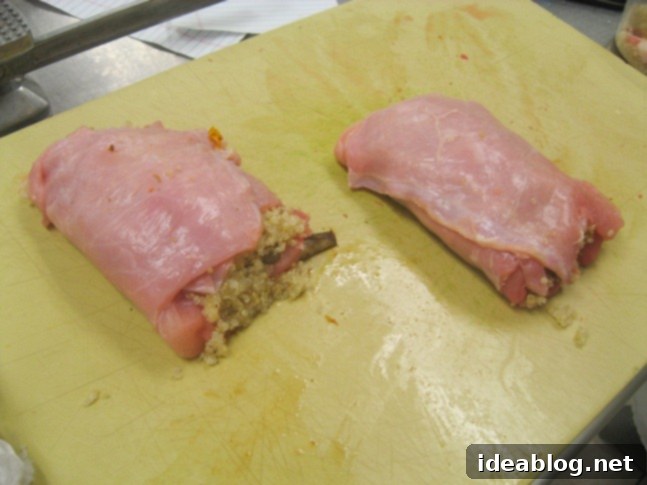
The Main Course: Stuffed Boneless Rabbit Saddle with Homemade Chive Pasta and Asparagus
Our main course proved to be a more labor-intensive but incredibly rewarding endeavor. The star of the plate was a meticulously prepared boneless rabbit saddle, expertly stuffed with a delectable mixture of sautéed spinach, earthy sautéed mushrooms, perfectly cooked quinoa for texture, and sun-dried tomatoes for a burst of concentrated flavor. The most intricate part of this preparation was undoubtedly removing the spine from the rabbit saddle without puncturing the delicate skin. This requires extreme care, precise knife work, and a steady hand – a true test of our butchery skills. Maintaining the integrity of the skin is crucial, as it forms the casing for the stuffing and ensures a beautiful presentation. To further secure the stuffing and maintain the saddle’s elegant shape during cooking, we delicately wrapped each prepared rabbit saddle in caul fat. Caul fat, a lacy membrane of fat from a pig’s stomach, is frequently used in classical French cuisine to baste lean meats, keep them moist, and add a subtle richness as it melts away during cooking.
The stuffed rabbit saddles were then gently braised, a slow cooking method that tenderizes the meat beautifully while infusing it with deep flavors. The braising liquid itself was a masterpiece, built on a foundation of expertly seared mirepoix (a classic aromatic base of diced carrots, celery, and onions) and the very rabbit bones we had meticulously removed, which contributed immense depth of flavor. This aromatic base was deglazed with a splash of crisp white wine, releasing all the caramelized bits from the pan, before being enriched with high-quality veal stock. This rich liquid simmered slowly with the rabbit, creating an incredibly tender dish. At the end of the braising process, this flavorful liquid was carefully reduced, concentrating its essences into a luxurious, glossy sauce that perfectly complemented the delicate rabbit meat and its savory stuffing.
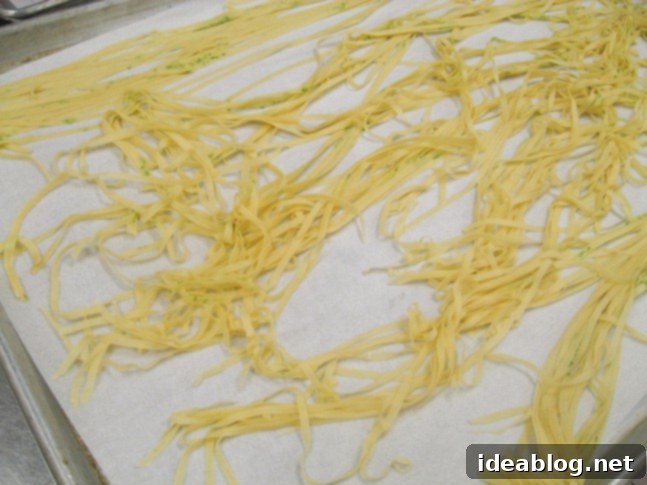
To accompany our exquisite rabbit main course, we also crafted fresh homemade pasta. At this stage of our culinary program, the skill of making pasta from scratch has become second nature, and it’s almost a given that it will feature prominently in our fifth practical exam this Friday. Each practical exam builds upon previous techniques, and pasta making is a fundamental skill that demonstrates proficiency in dough work and precision. To add an extra layer of visual appeal and a subtle herbaceous flavor, we incorporated finely chopped chives directly into the pasta dough as we were rolling it out. The flecks of green provided a lovely color variation, making the pasta not only delicious but also visually engaging. The texture of freshly made pasta is unparalleled, offering a tender bite that perfectly absorbs the rich braising sauce from the rabbit.
Completing the plate was a simple yet essential side of plain asparagus. These vibrant green spears were, of course, meticulously peeled to ensure uniform tenderness and a refined presentation. The clean, slightly bitter notes of the asparagus provided a refreshing counterpoint to the richness of the rabbit and pasta, balancing the overall flavor profile of the main course.
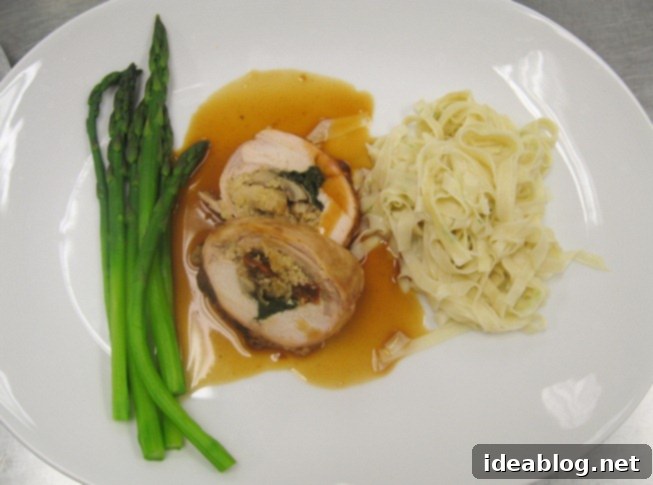
The Sweet Conclusion: Delightful Blueberry Clafoutis
Our dessert was yet another triumph: a beautifully executed blueberry clafoutis. Traditionally, clafoutis, a classic French baked custard, is made with black cherries, often left unpitted. The pits, believe it or not, are believed to release a subtle almond-like flavor into the custard during baking and also prevent the cherry juices from bleeding too much into the batter, maintaining the fruit’s integrity. However, the beauty of clafoutis lies in its versatility; it can truly be made with almost any type of fruit. Given that fresh cherries are not in season, we creatively adapted the recipe. We opted for fresh blueberries – an ironic choice, as they too are technically out of season, but readily available and delicious. To add a layer of complexity and a nod to tradition, we also incorporated a handful of griottes, which are dried cherries meticulously soaked in alcohol, providing an intense, boozy fruit flavor that was truly delightful.
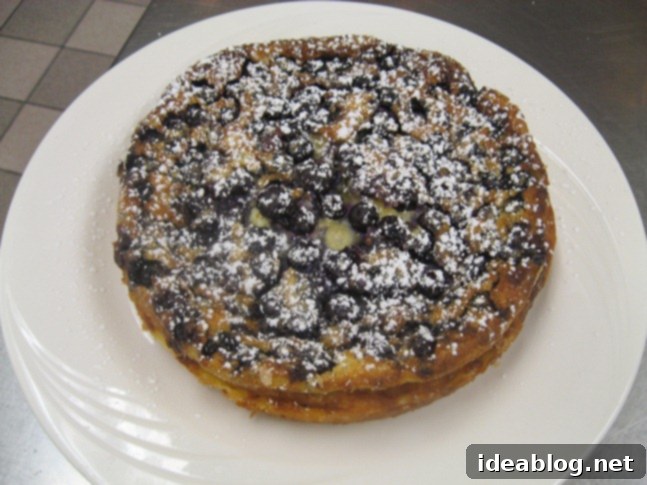
The batter for clafoutis is remarkably simple to prepare, sharing many similarities with a classic crepe batter. It’s a straightforward combination of all-purpose flour and fragrant almond flour, which lends a beautiful depth of flavor and tender crumb. Sugar provides sweetness, while rich cream, wholesome milk, and fresh eggs bind everything together, creating a smooth, pourable consistency. The resulting dessert is wonderfully moist and possesses a delicate, custard-like flavor and texture, almost melting in the mouth. I genuinely loved this dessert! Its elegant simplicity belied its incredibly satisfying taste, making it a perfect example of how refined flavors can emerge from humble ingredients and straightforward techniques. The ease of its preparation makes it a strong contender for future baking endeavors at home.
I can certainly foresee many more clafoutis in my future culinary adventures!
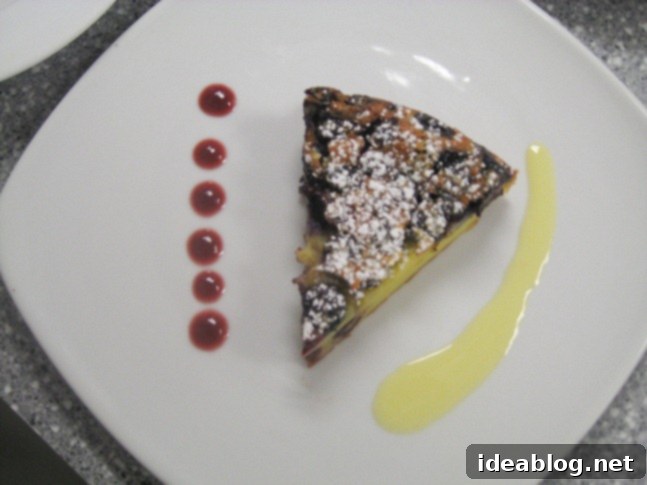
Looking Ahead: Venison, Exams, and the Culinary Grind
We concluded the day by diligently preparing our marinade for a venison dish scheduled for this Thursday. This forward planning is typical of culinary school, where organization and mise en place are paramount to success. Preparing components in advance ensures efficiency and allows flavors to develop, which is crucial for complex dishes like venison.
And now, my focus shifts entirely to studying for the impending tests. The practical exam, with its rigorous demands on technique, speed, and precision, looms large. Simultaneously, the theory exam requires a deep understanding of culinary science, history, and classical techniques. Most likely, this means an early night for me tonight, as proper rest is just as important as studying when facing such mentally and physically demanding challenges. I am absolutely exhausted, but exhilarated by the learning process! Posting updates this week might be a bit sporadic given the intense schedule, but I am committed to keeping you all informed and sharing more about this incredible culinary journey as I navigate the pressures and triumphs of Week 20.
